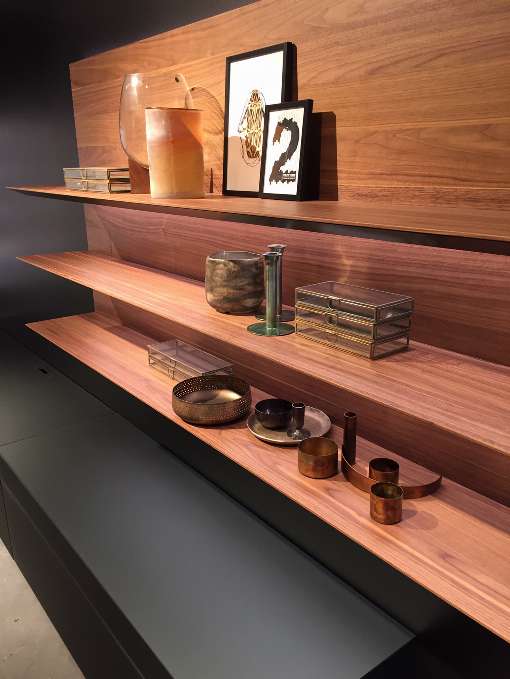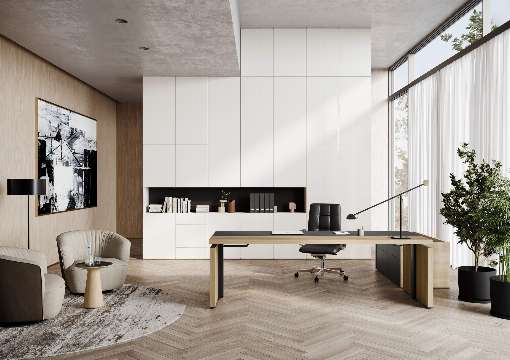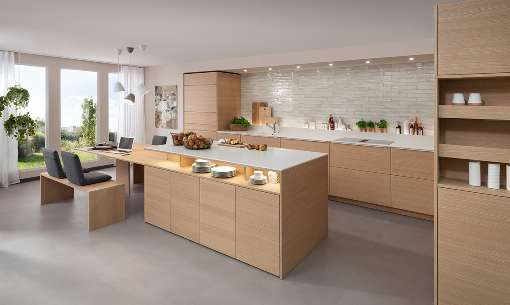16.08.2023
Tips for buying ecological furniture:
Bonn. The image of real wood veneer has changed considerably in recent decades. In the past, veneer surfaces on furniture were considered inferior to solid wood. This is no longer the case, as most cabinets, chests of drawers and modular furniture are no longer made of solid wood but of wood-based panels. The printed surface foils that are then often used may look like real wood, but they are not. They mislead customers into believing that they have bought a sustainable product. If you want to pay attention to the ecological quality of your furniture, you should definitely prefer real wood veneer.
Veneers are being used more and more by parts of the international furniture industry as an ecological alternative to foils. This is good news for the environment and for customers who are concerned about climate protection. However, misleading and deceptive practices are common in the furniture trade. Therefore, one should ask in the furniture store exactly which material it really is. Furniture often looks as if it were made of wood, but is covered with printed foils that only pretend to be wood. Unfortunately, often not even the product names give information about the quality, when furniture is called "oak Manuela" or "Florence oak". The surface is natural and ecological only if it is made of veneer. And this is something that the salespeople should know and be able to communicate to their customers. Only veneer is made of real, thinly cut wood. And only real wood can be called veneer.
Currently, oak is the most popular wood in terms of sales. Its variety has many color shades and patterns to offer. From a calm, uniformly light tone to a medium brown color accent or structured with medullary rays or knots, good old oak offers something to suit every taste. Likewise, the rough-sawn surface with veneer is possible and offers a lively character, perfectly suited for chests of drawers or sideboards. In addition to the oak wood trend, the light wood of maple, the medium to dark brown American walnut and the yellowish light birch are coming back into the furniture range. The increasing demand from the international furniture industry for softwood veneers is also striking. Here it is larch, pine and fir that are increasingly being processed into veneer. "This positive demand shows us the increasing sensitivity of consumers for ecological products. Anyone who buys a piece of furniture today wants to have as little impact on the environment as possible. Veneered furniture saves resources, is climate-friendly, durable and genuine," says Ursula Geismann, living analyst and managing director of the Initiative Furnier + Natur (IFN). Veneered cabinets, shelves, tables, sideboards, chairs, wardrobes, etc. are suitable as living room, kitchen, office, bathroom and, of course, children's furniture. IFN/UG
Further information at:
Kettnaker.de
Walter Knoll.de
Rempp Küchen.de
furnier.de
www.furniergeschichten.de
facebook
linkedin
instagram
Image 1: Flexible shelving systems with veneer surfaces for the living room are sustainable, genuine and beautiful. Photo: IFN/Kettnaker
Image 2: Clear shapes, warm colors: the "Mono-V" desk. Design: Wolfgang C. R. Mezger. Photo: Walter Knoll
Image 3: Also popular for kitchen furniture: real wood veneer in all variations. Photo: Rempp Kitchens
August 16, 2023
Tips for buying ecological furniture:
Prefer veneer as a surface
Bonn. The image of real wood veneer has changed considerably in recent decades. In the past, veneer surfaces on furniture were considered inferior to solid wood. This is no longer the case, as most cabinets, chests of drawers and modular furniture are no longer made of solid wood but of wood-based panels. The printed surface foils that are then often used may look like real wood, but they are not. They mislead customers into believing that they have bought a sustainable product. If you want to pay attention to the ecological quality of your furniture, you should definitely prefer real wood veneer.
Veneers are being used more and more by parts of the international furniture industry as an ecological alternative to foils. This is good news for the environment and for customers who are concerned about climate protection. However, misleading and deceptive practices are common in the furniture trade. Therefore, one should ask in the furniture store exactly which material it really is. Furniture often looks as if it were made of wood, but is covered with printed foils that only pretend to be wood. Unfortunately, often not even the product names give information about the quality, when furniture is called "oak Manuela" or "Florence oak". The surface is natural and ecological only if it is made of veneer. And this is something that the salespeople should know and be able to communicate to their customers. Only veneer is made of real, thinly cut wood. And only real wood can be called veneer.
Currently, oak is the most popular wood in terms of sales. Its variety has many color shades and patterns to offer. From a calm, uniformly light tone to a medium brown color accent or structured with medullary rays or knots, good old oak offers something to suit every taste. Likewise, the rough-sawn surface with veneer is possible and offers a lively character, perfectly suited for chests of drawers or sideboards. In addition to the oak wood trend, the light wood of maple, the medium to dark brown American walnut and the yellowish light birch are coming back into the furniture range. The increasing demand from the international furniture industry for softwood veneers is also striking. Here it is larch, pine and fir that are increasingly being processed into veneer. "This positive demand shows us the increasing sensitivity of consumers for ecological products. Anyone who buys a piece of furniture today wants to have as little impact on the environment as possible. Veneered furniture saves resources, is climate-friendly, durable and genuine," says Ursula Geismann, living analyst and managing director of the Initiative Furnier + Natur (IFN). Veneered cabinets, shelves, tables, sideboards, chairs, wardrobes, etc. are suitable as living room, kitchen, office, bathroom and, of course, children's furniture. IFN/UG
Further information at:
Kettnaker.de
Walter Knoll.de
Rempp Küchen.de
furnier.de
www.furniergeschichten.de
Image 1: Flexible shelving systems with veneer surfaces for the living room are sustainable, genuine and beautiful. Photo: IFN/Kettnaker
Image 2: Clear shapes, warm colors: the "Mono-V" desk. Design: Wolfgang C. R. Mezger. Photo: Walter Knoll
Image 3: Also popular for kitchen furniture: real wood veneer in all variations. Photo: Rempp Kitchens
August 16, 2023

Image 1: Flexible shelving systems with veneer surfaces for the living room are sustainable, genuine and beautiful. Photo: IFN/Kettnaker

Image 2: Clear shapes, warm colors: the "Mono-V" desk. Design: Wolfgang C. R. Mezger. Photo: Walter Knoll

Image 3: Also popular for kitchen furniture: real wood veneer in all variations. Photo: Rempp Kitchens